Mechanical Properties and Durability of Composite Cement Pastes Containing Phase-Change Materials and Nanosilica
Abstract
1. Introduction
2. Materials and Methods
3. Results and Discussion
3.1. Early-Stage Temperature Measurements
3.2. Compressive Strength
3.3. X-ray Diffraction
3.4. Scanning Electron Microscopy
3.5. Thermal Conductivity
3.6. Nitrogen Physisorption
3.7. Depth of Carbonation
3.8. Electrical Resistivity
3.9. Water Absorption (Sorptivity)
3.10. Thermal Behavior
4. Conclusions
- The temperatures recorded by K-type thermocouples during the semi-adiabatic process in the fresh pastes, with data collected every 2 s, revealed that adding 10% PCMs by the mass of cement reduced the hydration time and temperature at early ages. This reduction is attributed to the PCM’s heat absorption capacity and intrinsic thermal conductivity properties.
- SEM images confirmed that PCM particles have individual sizes of 3 μm and tend to agglomerate in spherical shapes ranging from 50 to 170 μm in diameter. These spheres fill spaces in the cementitious matrix, physically altering microstructure and porosities. These modifications compromise certain properties, such as compressive strength. It was found that adding 10% PCM led to a reduction of nearly 33% in strength. Additionally, electrical resistivity values drastically decreased when the PCM content exceeded 3%, with a reduction of 87% as compared to the reference sample (R). These decreases confirmed that the PCM modified the microstructure acting as microfiller, hence altering the electrical resistivity, and these observations were supported by the SEM results.
- For samples cured up to 90 days, deep carbonation measurements were conducted by exposing samples to a controlled atmosphere for 7 days, followed by fracturing and spraying them with a phenolphthalein indicator solution. Samples exhibiting lower thermal conductivity (FA3 and FA10) showed lower depths of carbonation in the presence of the PCM, hence reducing risk of penetration by aggressive agents.
- Another improved property was water absorption. Samples dried for 3 days and exposed to water demonstrated that PCMs behaved like non-adsorbent materials. Specifically, FA3 exhibited better performance in terms of the final absorption rate, while for FA samples, the initial absorption rate was improved.
- Regarding thermal behavior, temperature measurements obtained by K-type thermocouples during 7-day exposure to the external conditions indicated that PCM addition could potentially enhance thermal comfort within buildings. Consequently, the use of PCMs in combination with high-fly-ash-containing Portland cement blends present a viable option for thermal insulation and, by extension, the mitigation of global warming.
Author Contributions
Funding
Data Availability Statement
Acknowledgments
Conflicts of Interest
References
- Zheng, S.; Huang, G.; Zhou, X.; Zhu, X. Climate-Change Impacts on Electricity Demands at a Metropolitan Scale: A Case Study of Guangzhou, China. Appl. Energy 2020, 261, 114295. [Google Scholar] [CrossRef]
- Rohde, R.; Muller, R.A.; Jacobsen, R.; Muller, E.; Perlmutter, S.; Rosenfeld, A.; Wurtele, J.; Groom, D.; Wickham, C. A New Estimate of the Average Earth Surface Land Temperature Spanning 1753 to 2011. Geoinformatics Geostat. Overv. 2013, 7, 2. [Google Scholar] [CrossRef]
- Charpentier-Alfaro, C.; Benavides-Hernández, J.; Poggerini, M.; Crisci, A.; Mele, G.; Della Rocca, G.; Emiliani, G.; Frascella, A.; Torrigiani, T.; Palanti, S. Wood-Decaying Fungi: From Timber Degradation to Sustainable Insulating Biomaterials Production. Materials 2023, 16, 3547. [Google Scholar] [CrossRef]
- Gandía, L.M.; Arzamendi, G.; Diéguez, P.M. Renewable Hydrogen Energy: An Overview. Int. J. Hydrogen Energy 2020, 45, 3847–3869. [Google Scholar] [CrossRef]
- Ahmad, T.; Zhang, D. A Critical Review of Comparative Global Historical Energy Consumption and Future Demand: The Story Told So Far. Energy Rep. 2020, 6, 1973–1991. [Google Scholar] [CrossRef]
- Bourdeau, M.; Zhai, X.Q.; Nefzaoui, E.; Guo, X.; Chatellier, P. Modelling and Forecasting Building Energy Consumption: A Review of Data-Driven Techniques. Sustain. Cities Soc. 2019, 48, 101533. [Google Scholar] [CrossRef]
- Kim, T.-Y.; Cho, S.-B. Predicting Residential Energy Consumption Using Cnn-Lstm Neural Networks. Energy 2019, 182, 72–81. [Google Scholar] [CrossRef]
- Sachs, J.; Moya, D.; Giarola, S.; Hawkes, A. Clustered Spatially and Temporally Resolved Global Heat and Cooling Energy Demand in the Residential Sector. Appl. Energy 2019, 250, 48–62. [Google Scholar] [CrossRef]
- Agency, International Energy. The Future of Cooling, Iea, Paris. Available online: https://www.iea.org/reports/the-future-of-cooling (accessed on 17 January 2023).
- Davis, L.W.; Gertler, P.J. Contribution of Air Conditioning Adoption to Future Energy Use under Global Warming. Proc. Natl. Acad. Sci. USA 2015, 112, 5962–5967. [Google Scholar] [CrossRef]
- Rosas-Flores, J.A.; Rosas-Flores, D. Potential Energy Savings and Mitigation of Emissions by Insulation for Residential Buildings in Mexico. Energy Build. 2020, 209, 109698. [Google Scholar] [CrossRef]
- Pérez-Lombard, L.; Ortiz, J.; Pout, C. A Review on Buildings Energy Consumption Information. Energy Build. 2008, 40, 394–398. [Google Scholar] [CrossRef]
- Mehdaoui, F.; Hazami, M.; Messaouda, A.; Taghouti, H.; Guizani, A. Value Added Utilization of by-Product Electric Furnace Ferronickel Slag as Construction Materials: A Review. Resour. Conserv. Recycl. 2018, 134, 10–24. [Google Scholar] [CrossRef]
- van den Heede, P.; De Belie, N. Environmental Impact and Life Cycle Assessment (Lca) of Traditional and ‘Green’concretes: Literature Review and Theoretical Calculations. Cem. Concr. Compos. 2012, 34, 431–442. [Google Scholar] [CrossRef]
- Escalante-García, J.; Magallanes-Rivera, R.; Gorokhovsky, A. Waste Gypsum–Blast Furnace Slag Cement in Mortars with Granulated Slag and Silica Sand as Aggregates. Constr. Build. Mater. 2009, 23, 2851–2855. [Google Scholar] [CrossRef]
- Iñiguez-Sánchez, C.; Gómez-Zamorano, L.; Alonso, M. Impact of Nano-Geothermal Silica Waste and Chloride Content on Pore Solution, Microstructure, and Hydration Products in Portland Cement Pastes. J. Mater. Sci. 2012, 47, 3639–3647. [Google Scholar] [CrossRef]
- Li, Y.; Yang, L.; He, B.; Zhao, D. Green Building in China: Needs Great Promotion. Sustain. Cities Soc. 2014, 11, 1–6. [Google Scholar] [CrossRef]
- Li, Y.; Han, M.; Liu, S.; Chen, G. Energy Consumption and Greenhouse Gas Emissions by Buildings: A Multi-Scale Perspective. Build. Environ. 2019, 151, 240–250. [Google Scholar] [CrossRef]
- Ling, T.-C.; Poon, C.-S. Use of Phase Change Materials for Thermal Energy Storage in Concrete: An Overview. Constr. Build. Mater. 2013, 46, 55–62. [Google Scholar] [CrossRef]
- Rao, V.V.; Parameshwaran, R.; Ram, V.V. PCM-Mortar Based Construction Materials for Energy Efficient Buildings: A Review on Research Trends. Energy Build. 2018, 158, 95–122. [Google Scholar] [CrossRef]
- Huang, X.; Chen, X.; Li, A.; Atinafu, D.; Gao, H.; Dong, W.; Wang, G. Shape-Stabilized Phase Change Materials Based on Porous Supports for Thermal Energy Storage Applications. Chem. Eng. J. 2019, 356, 641–661. [Google Scholar] [CrossRef]
- Shaban, M.; Khan, T.I.; Anwar, M.; Alzaid, M.; Alanazi, R. Effect of Asymmetric Fins on Thermal Performance of Phase Change Material-Based Thermal Energy Storage Unit. Materials 2023, 16, 2567. [Google Scholar] [CrossRef]
- Soares, N.; Costa, J.J.; Gaspar, A.R.; Santos, P. Review of Passive Pcm Latent Heat Thermal Energy Storage Systems Towards Buildings’ Energy Efficiency. Energy Build. 2013, 59, 82–103. [Google Scholar] [CrossRef]
- Waqas, A.; Ud Din, Z. Phase Change Material (Pcm) Storage for Free Cooling of Buildings—A Review. Renew. Sustain. Energy Rev. 2013, 18, 607–625. [Google Scholar] [CrossRef]
- Sharma, A.; Tyagi, V.V.; Chen, C.R.; Buddhi, D. Review on Thermal Energy Storage with Phase Change Materials and Applications. Renew. Sustain. Energy Rev. 2009, 13, 318–345. [Google Scholar] [CrossRef]
- Pasupathy, A.; Velraj, R.; Seeniraj, R. Phase Change Material-Based Building Architecture for Thermal Management in Residential and Commercial Establishments. Renew. Sustain. Energy Rev. 2008, 12, 39–64. [Google Scholar] [CrossRef]
- Reyez-Araiza, J.L.; Pineda-Piñón, J.; López-Romero, J.M.; Gasca-Tirado, J.R.; Contreras, M.A.; Correa, J.C.J.; Apátiga-Castro, L.M.; Rivera-Muñoz, E.M.; Velazquez-Castillo, R.R.; Bueno, J.d.J.P.; et al. Thermal Energy Storage by the Encapsulation of Phase Change Materials in Building Elements—A Review. Materials 2021, 14, 1420. [Google Scholar] [CrossRef]
- Regin, A.F.; Solanki, S.; Saini, J. Heat Transfer Characteristics of Thermal Energy Storage System Using Pcm Capsules: A Review. Renew. Sustain. Energy Rev. 2008, 12, 2438–2458. [Google Scholar] [CrossRef]
- Mohseni, E.; Tang, W.; Khayat, K.H.; Cui, H. Thermal Performance and Corrosion Resistance of Structural-Functional Concrete Made with Inorganic Pcm. Constr. Build. Mater. 2020, 249, 118768. [Google Scholar] [CrossRef]
- Li, G.; Hwang, Y.; Radermacher, R. Cold Thermal Energy Storage Materials and Applications toward Sustainability. In Energy Solutions to Combat Global Warming; Springer: Berlin/Heidelberg, Germany, 2017; pp. 67–117. [Google Scholar] [CrossRef]
- Ryms, M.; Klugmann-Radziemska, E. Possibilities and Benefits of a New Method of Modifying Conventional Building Materials with Phase-Change Materials (Pcms). Constr. Build. Mater. 2019, 211, 1013–1024. [Google Scholar] [CrossRef]
- Sharifi, N.P.; Shaikh, A.A.N.; Sakulich, A.R. Application of Phase Change Materials in Gypsum Boards to Meet Building Energy Conservation Goals. Energy Build. 2017, 138, 455–467. [Google Scholar] [CrossRef]
- Pilehvar, S.; Cao, V.D.; Szczotok, A.M.; Valentini, L.; Salvioni, D.; Magistri, M.; Pamies, R.; Kjøniksen, A.-L. Mechanical Properties and Microscale Changes of Geopolymer Concrete and Portland Cement Concrete Containing Micro-Encapsulated Phase Change Materials. Cem. Concr. Res. 2017, 100, 341–349. [Google Scholar] [CrossRef]
- Djamai, Z.I.; Salvatore, F.; Larbi, A.S.; Cai, G.; El Mankibi, M. Multiphysics Analysis of Effects of Encapsulated Phase Change Materials (Pcms) in Cement Mortars. Cem. Concr. Res. 2019, 119, 51–63. [Google Scholar] [CrossRef]
- Wei, Z.; Falzone, G.; Wang, B.; Thiele, A.; Puerta-Falla, G.; Pilon, L.; Neithalath, N.; Sant, G. The Durability of Cementitious Composites Containing Microencapsulated Phase Change Materials. Cem. Concr. Compos. 2017, 81, 66–76. [Google Scholar] [CrossRef]
- Šavija, B. Smart Crack Control in Concrete through Use of Phase Change Materials (PCMs): A Review. Materials 2018, 11, 654. [Google Scholar] [CrossRef]
- Jayalath, A.; Nicolas, R.S.; Sofi, M.; Shanks, R.; Ngo, T.; Aye, L.; Mendis, P. Properties of Cementitious Mortar and Concrete Containing Micro-Encapsulated Phase Change Materials. Constr. Build. Mater. 2016, 120, 408–417. [Google Scholar] [CrossRef]
- Haurie, L.; Serrano, S.; Bosch, M.; Fernandez, A.I.; Cabeza, L.F. Single Layer Mortars with Microencapsulated Pcm: Study of Physical and Thermal Properties, and Fire Behaviour. Energy Build. 2016, 111, 393–400. [Google Scholar] [CrossRef]
- Kośny, J. PCM-Enhanced Building Components: An Application of Phase Change Materials in Building Envelopes and Internal Structures; Derby, B., Ed.; Engineering Materials and Processes; Springer: Cham, Switzerland, 2015. [Google Scholar]
- Cui, H.; Liao, W.; Mi, X.; Lo, T.Y.; Chen, D. Study on Functional and Mechanical Properties of Cement Mortar with Graphite-Modified Microencapsulated Phase-Change Materials. Energy Build. 2015, 105, 273–284. [Google Scholar] [CrossRef]
- Essid, N.; Loulizi, A.; Neji, J. Compressive Strength and Hygric Properties of Concretes Incorporating Microencapsulated Phase Change Material. Constr. Build. Mater. 2019, 222, 254–262. [Google Scholar] [CrossRef]
- Šavija, B.; Zhang, H.; Schlangen, E. Influence of Microencapsulated Phase Change Material (Pcm) Addition on (Micro) Mechanical Properties of Cement Paste. Materials 2017, 10, 863. [Google Scholar] [CrossRef]
- Bat-Erdene, P.-E.; Pareek, S. Experimental Study on the Development of Fly Ash Foam Concrete Containing Phase Change Materials (Pcms). Materials 2022, 15, 8428. [Google Scholar] [CrossRef]
- Orsini, F.; Marrone, P.; Santini, S.; Sguerri, L.; Asdrubali, F.; Baldinelli, G.; Bianchi, F.; Presciutti, A. Smart Materials: Cementitious Mortars and Pcm Mechanical and Thermal Characterization. Materials 2021, 14, 4163. [Google Scholar] [CrossRef]
- Zetola, V.; Claros-Marfil, L.J.; Santos, A.G.; González, F.J.N. Effect of Paraffin and Silica Matrix Phase Change Materials on Properties of Portland Cement Mortars. Materials 2021, 14, 921. [Google Scholar] [CrossRef]
- Bao, X.; Tian, Y.; Yuan, L.; Cui, H.; Tang, W.; Fung, W.; Qi, H. Development of High Performance Pcm Cement Composites for Passive Solar Buildings. Energy Build. 2019, 194, 33–45. [Google Scholar] [CrossRef]
- Drissi, S.; Ling, T.-C.; Mo, K.H.; Eddhahak, A. A Review of Microencapsulated and Composite Phase Change Materials: Alteration of Strength and Thermal Properties of Cement-Based Materials. Renew. Sustain. Energy Rev. 2019, 110, 467–484. [Google Scholar] [CrossRef]
- Fabiani, C.; Pisello, A.L.; D’Alessandro, A.; Ubertini, F.; Cabeza, L.F.; Cotana, F. Effect of Pcm on the Hydration Process of Cement-Based Mixtures: A Novel Thermo-Mechanical Investigation. Materials 2018, 11, 871. [Google Scholar] [CrossRef]
- Maciel, M.H.; Soares, G.S.; de Oliveira Romano, R.C.; Cincotto, M.A. Monitoring of Portland Cement Chemical Reaction and Quantification of the Hydrated Products by Xrd and Tg in Function of the Stoppage Hydration Technique. J. Therm. Anal. Calorim. 2019, 136, 1269–1284. [Google Scholar] [CrossRef]
- Chi, L.; Wang, Z.; Lu, S.; Zhao, D.; Yao, Y. Development of Mathematical Models for Predicting the Compressive Strength and Hydration Process Using the Eis Impedance of Cementitious Materials. Constr. Build. Mater. 2019, 208, 659–668. [Google Scholar] [CrossRef]
- BS EN 13295:2004; Products and Systems for the Protection and Repair of Concrete Structures. Test Methods. Determination of Resistance to Carbonation. European Standards: London, UK, 2004.
- Fajardo, G.; Cruz-López, A.; Cruz-Moreno, D.; Valdez, P.; Torres, G.; Zanella, R. Innovative Application of Silicon Nanoparticles (Sn): Improvement of the Barrier Effect in Hardened Portland Cement-Based Materials. Constr. Build. Mater. 2015, 76, 158–167. [Google Scholar] [CrossRef]
- ASTM C-1585-20; Standard Test Method for Measurement of Rate of Absorption of Water by Hydraulic-Cement Concretes. ASTM International: West Conshohocken, PA, USA, 2020.
- Snoeck, D.; Priem, B.; Dubruel, P.; De Belie, N. Encapsulated Phase-Change Materials as Additives in Cementitious Materials to Promote Thermal Comfort in Concrete Constructions. Mater. Struct. 2016, 49, 225–239. [Google Scholar] [CrossRef]
- She, Z.; Wei, Z.; Young, B.A.; Falzone, G.; Neithalath, N.; Sant, G.; Pilon, L. Examining the Effects of Microencapsulated Phase Change Materials on Early-Age Temperature Evolutions in Realistic Pavement Geometries. Cem. Concr. Compos. 2019, 103, 149–159. [Google Scholar] [CrossRef]
- Young, B.A.; Falzone, G.; She, Z.; Thiele, A.M.; Wei, Z.; Neithalath, N.; Sant, G.; Pilon, L. Early-Age Temperature Evolutions in Concrete Pavements Containing Microencapsulated Phase Change Materials. Constr. Build. Mater. 2017, 147, 466–477. [Google Scholar] [CrossRef]
- Kim, Y.-R.; Khil, B.-S.; Jang, S.-J.; Choi, W.-C.; Yun, H.-D. Effect of Barium-Based Phase Change Material (Pcm) to Control the Heat of Hydration on the Mechanical Properties of Mass Concrete. Thermochim. Acta 2015, 613, 100–107. [Google Scholar] [CrossRef]
- Cellat, K.; Beyhan, B.; Güngör, C.; Konuklu, Y.; Karahan, O.; Dündar, C.; Paksoy, H. Thermal Enhancement of Concrete by Adding Bio-Based Fatty Acids as Phase Change Materials. Energy Build. 2015, 106, 156–163. [Google Scholar] [CrossRef]
- Eddhahak, A.; Drissi, S.; Colin, J.; Caré, S.; Neji, J. Effect of Phase Change Materials on the Hydration Reaction and Kinetic of Pcm-Mortars. J. Therm. Anal. Calorim. 2014, 117, 537–545. [Google Scholar] [CrossRef]
- Bi, L.; Long, G.; Ma, C.; Wu, J.; Xie, Y. Effect of Phase Change Composites on Hydration Characteristics of Steam-Cured Cement Paste. Constr. Build. Mater. 2021, 274, 122030. [Google Scholar] [CrossRef]
- Srinivasaraonaik, B.; Sinha, S.; Singh, L.P. Studies on Microstructural and Thermo-Physico Properties of Microencapsulated Eutectic Phase Change Material Incorporated Pure Cement System. J. Energy Storage 2021, 35, 102318. [Google Scholar] [CrossRef]
- Guardia, C.; Barluenga, G.; Palomar, I.; Diarce, G. Thermal Enhanced Cement-Lime Mortars with Phase Change Materials (Pcm), Lightweight Aggregate and Cellulose Fibers. Constr. Build. Mater. 2019, 221, 586–594. [Google Scholar] [CrossRef]
- Zhang, X.; Xu, M.; Liu, L.; Huan, C.; Zhao, Y.; Qi, C.; Song, K.-I. Experimental Study on Thermal and Mechanical Properties of Cemented Paste Backfill with Phase Change Material. J. Mater. Res. Technol. 2020, 9, 2164–2175. [Google Scholar] [CrossRef]
- Lecompte, T.; Le Bideau, P.; Glouannec, P.; Nortershauser, D.; Le Masson, S. Mechanical and Thermo-Physical Behaviour of Concretes and Mortars Containing Phase Change Material. Energy Build. 2015, 94, 52–60. [Google Scholar] [CrossRef]
- Shadnia, R.; Zhang, L.; Li, P. Experimental Study of Geopolymer Mortar with Incorporated Pcm. Constr. Build. Mater. 2015, 84, 95–102. [Google Scholar] [CrossRef]
- Xu, J.; Wang, B.; Zuo, J. Modification Effects of Nanosilica on the Interfacial Transition Zone in Concrete: A Multiscale Approach. Cem. Concr. Compos. 2017, 81, 1–10. [Google Scholar] [CrossRef]
- Yan, Y.; Tian, L.; Zhao, W.; Lazaro, S.A.M.; Li, X.; Tang, S. Dielectric and Mechanical Properties of Cement Pastes Incorporated with Magnetically Aligned Reduced Graphene Oxide. Dev. Built Environ. 2024, 18, 100471. [Google Scholar] [CrossRef]
- de Sensale, G.R.; Viacava, I.R. A Study on Blended Portland Cements Containing Residual Rice Husk Ash and Limestone Filler. Constr. Build. Mater. 2018, 166, 873–888. [Google Scholar] [CrossRef]
- Escalante-Garcia, J.; Martínez-Aguilar, O.; Gomez-Zamorano, L. Calcium Sulphate Anhydrite Based Composite Binders; Effect of Portland Cement and Four Pozzolans on the Hydration and Strength. Cem. Concr. Compos. 2017, 82, 227–233. [Google Scholar] [CrossRef]
- Gómez-Zamorano, L.Y.; García-Guillén, G.; Acevedo-Dávila, J.L. Study on the Hydration of Portland Cement Paste Replaced with Blast Furnace Slag, Fly Ash, and Metakaolin: Effect on the Usage of Two Uperplasticizer Additives. ALCONPAT J. 2015, 5, 203–218. [Google Scholar]
- Wang, L.; Guo, F.; Lin, Y.; Yang, H.; Tang, S. Comparison between the Effects of Phosphorous Slag and Fly Ash on the Csh Structure, Long-Term Hydration Heat and Volume Deformation of Cement-Based Materials. Constr. Build. Mater. 2020, 250, 118807. [Google Scholar] [CrossRef]
- Wang, L.; Guo, F.X.; Yang, H.M.; Wang, Y.; Tang, S.W. Comparison of FLY ASH, PVA Fiber, MgO and Shrinkage-Reducing Admixture on the Frost Resistance of Face Slab Concrete Via Pore Structural and Fractal Analysis. Fractals 2021, 29, 2140002. [Google Scholar] [CrossRef]
- Wang, L.; Jin, M.M.; Guo, F.X.; Wang, Y.; Tang, S.W. Pore Structural and Fractal Analysis of the Influence of Fly Ash and Silica Fume on the Mechanical Property and Abrasion Resistance of Concrete. Fractals 2021, 29, 2140003. [Google Scholar] [CrossRef]
- Olivieri, L.; Tenorio, J.A.; Revuelta, D.; Navarro, L.; Cabeza, L.F. Developing a Pcm-Enhanced Mortar for Thermally Active Precast Walls. Constr. Build. Mater. 2018, 181, 638–649. [Google Scholar] [CrossRef]
- Hassan, A.; Laghari, M.S.; Rashid, Y. Micro-Encapsulated Phase Change Materials: A Review of Encapsulation, Safety and Thermal Characteristics. Sustainability 2016, 8, 1046. [Google Scholar] [CrossRef]
- Ricklefs, A.; Thiele, A.M.; Falzone, G.; Sant, G.; Pilon, L. Thermal Conductivity of Cementitious Composites Containing Microencapsulated Phase Change Materials. Int. J. Heat Mass Transf. 2017, 104, 71–82. [Google Scholar] [CrossRef]
- Thommes, M.; Kaneko, K.; Neimark, A.V.; Olivier, J.P.; Rodriguez-Reinoso, F.; Rouquerol, J.; Sing, K.S.W. Physisorption of Gases, with Special Reference to the Evaluation of Surface Area and Pore Size Distribution (Iupac Technical Report). Pure Appl. Chem. 2015, 87, 1051–1069. [Google Scholar] [CrossRef]
- Lucas, S.; Ferreira, V.; de Aguiar, J.B. Latent Heat Storage in Pcm Containing Mortars—Study of Microstructural Modifications. Energy Build. 2013, 66, 724–731. [Google Scholar] [CrossRef]
- Lizarazo-Marriaga, J.; Higuera, C.; Claisse, P. Measuring the Effect of the Itz on the Transport Related Properties of Mortar Using Electrochemical Impedance. Constr. Build. Mater. 2014, 52, 9–16. [Google Scholar] [CrossRef]
- Sahu, A.; Dey, T.; Chakraborty, S. Influence of Nano Silica on Mechanical and Durability Characteristic of Mortar Made by Partial Replacement of Natural Fine Aggregate with Recycled Fine Aggregate. Silicon 2021, 13, 4391–4405. [Google Scholar] [CrossRef]
- Li, L.G.; Zheng, J.Y.; Ng, P.-L.; Kwan, A.K.H. Synergistic Cementing Efficiencies of Nano-Silica and Micro-Silica in Carbonation Resistance and Sorptivity of Concrete. J. Build. Eng. 2021, 33, 101862. [Google Scholar] [CrossRef]
- ANSI/ASHRAE Standard 55-2017; Thermal Environmental Conditions for Human Occupancy. ASHRAE: Atlanta, GA, USA, 2017.
- Cabeza, L.F.; Castellón, C.; Nogués, M.; Medrano, M.; Leppers, R.; Zubillaga, O. Use of Microencapsulated Pcm in Concrete Walls for Energy Savings. Energy Build. 2007, 39, 113–119. [Google Scholar] [CrossRef]
- Cabeza, L.; Castell, A.; Medrano, M.; Martorell, I.; Pérez, G.; Fernández, I. Experimental Study on the Performance of Insulation Materials in Mediterranean Construction. Energy Build. 2010, 42, 630–636. [Google Scholar] [CrossRef]
- Andrés, M.; Rebelo, F.; Corredera, Á.; Figueiredo, A.; Hernández, J.L.; Ferreira, V.M.; Bujedo, L.A.; Vicente, R.; Morentin, F.; Samaniego, J. Real-Scale Experimental Evaluation of Energy and Thermal Regulation Effects of Pcm-Based Mortars in Lightweight Constructions. Appl. Sci. 2022, 12, 2091. [Google Scholar] [CrossRef]
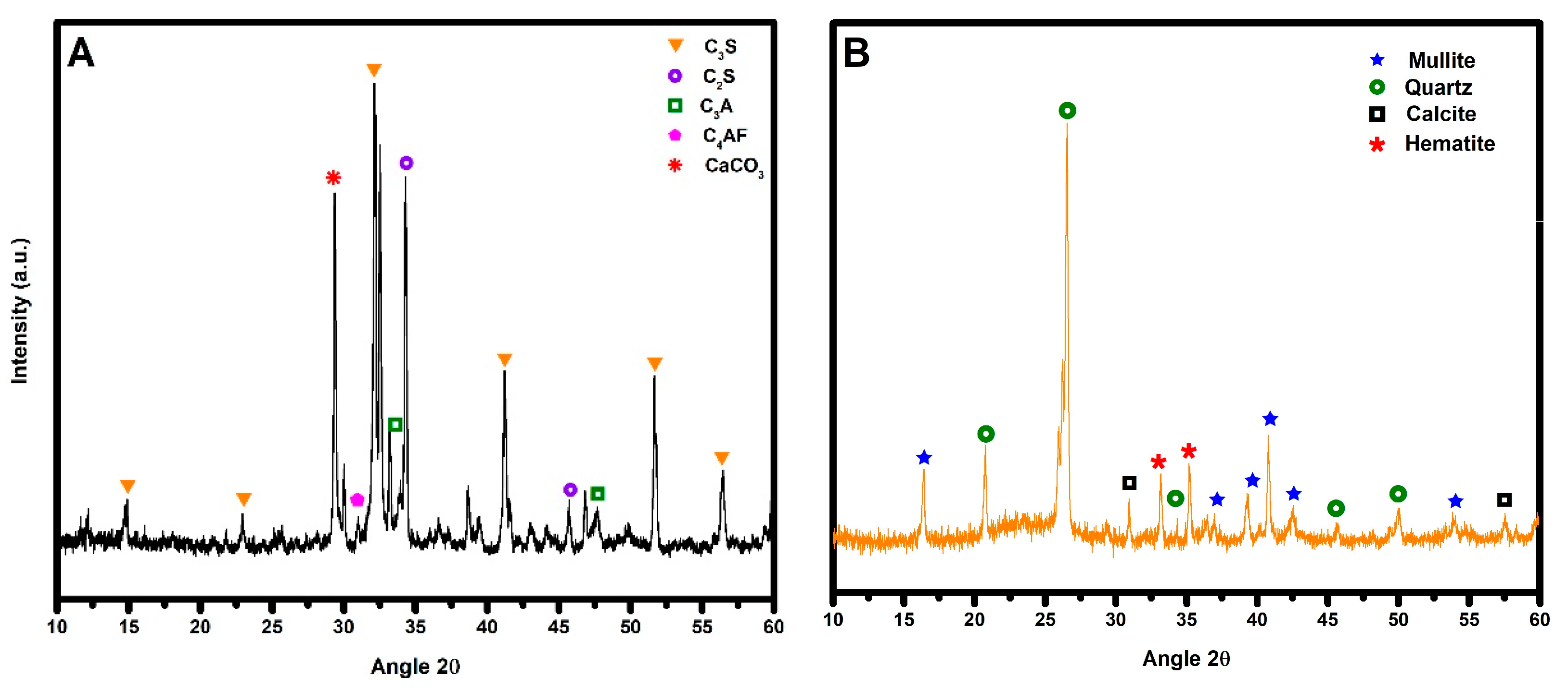


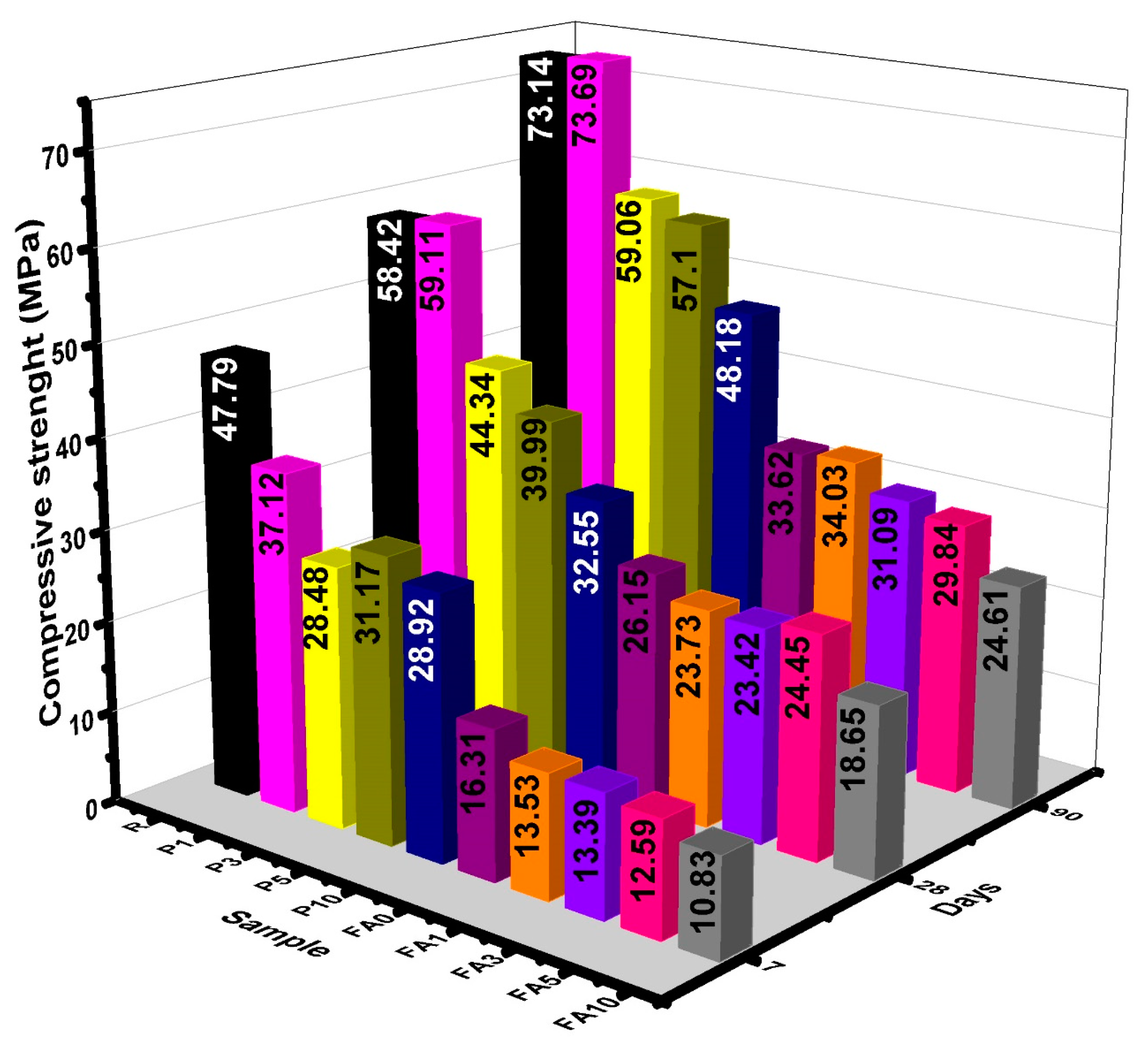
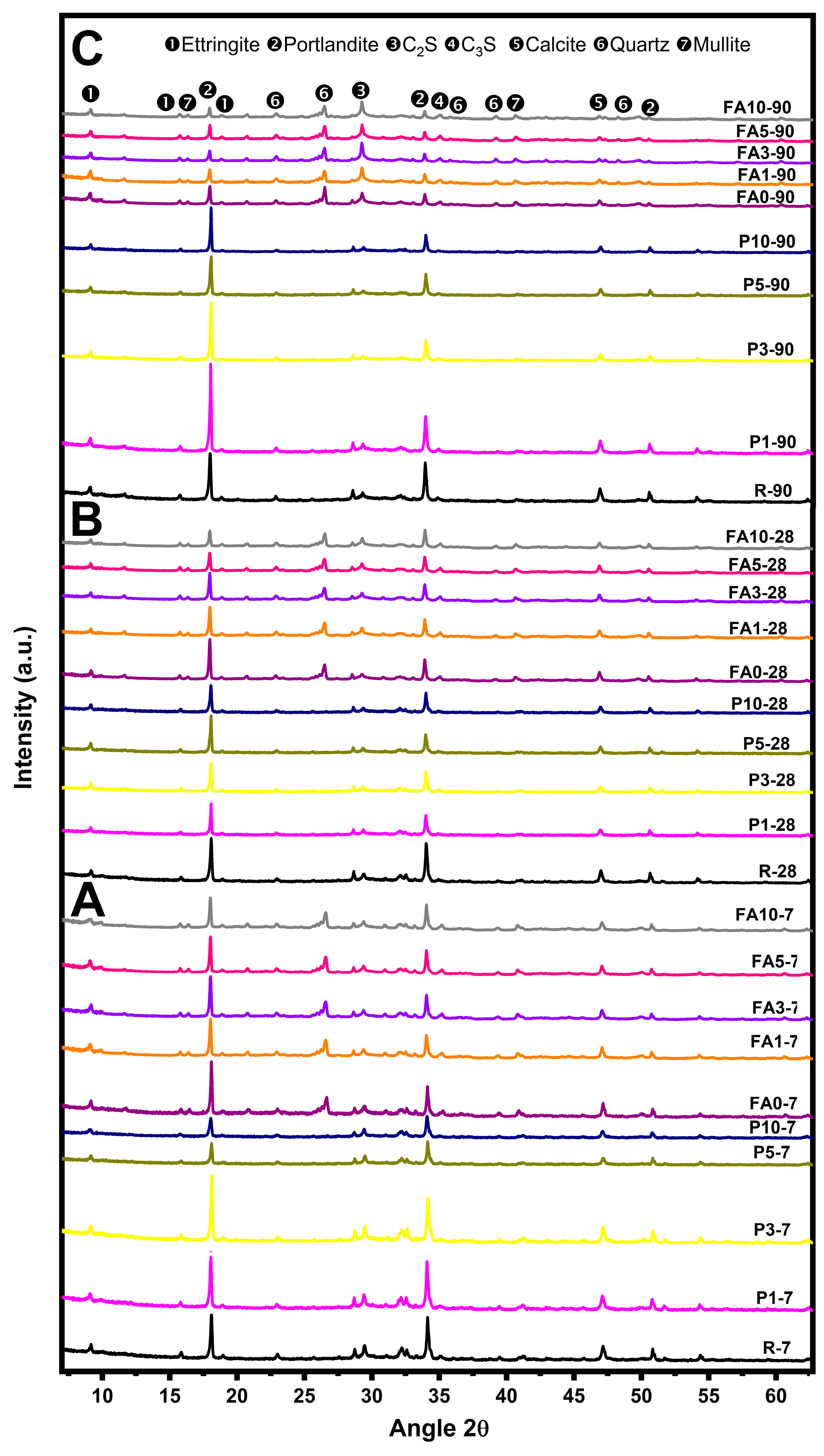

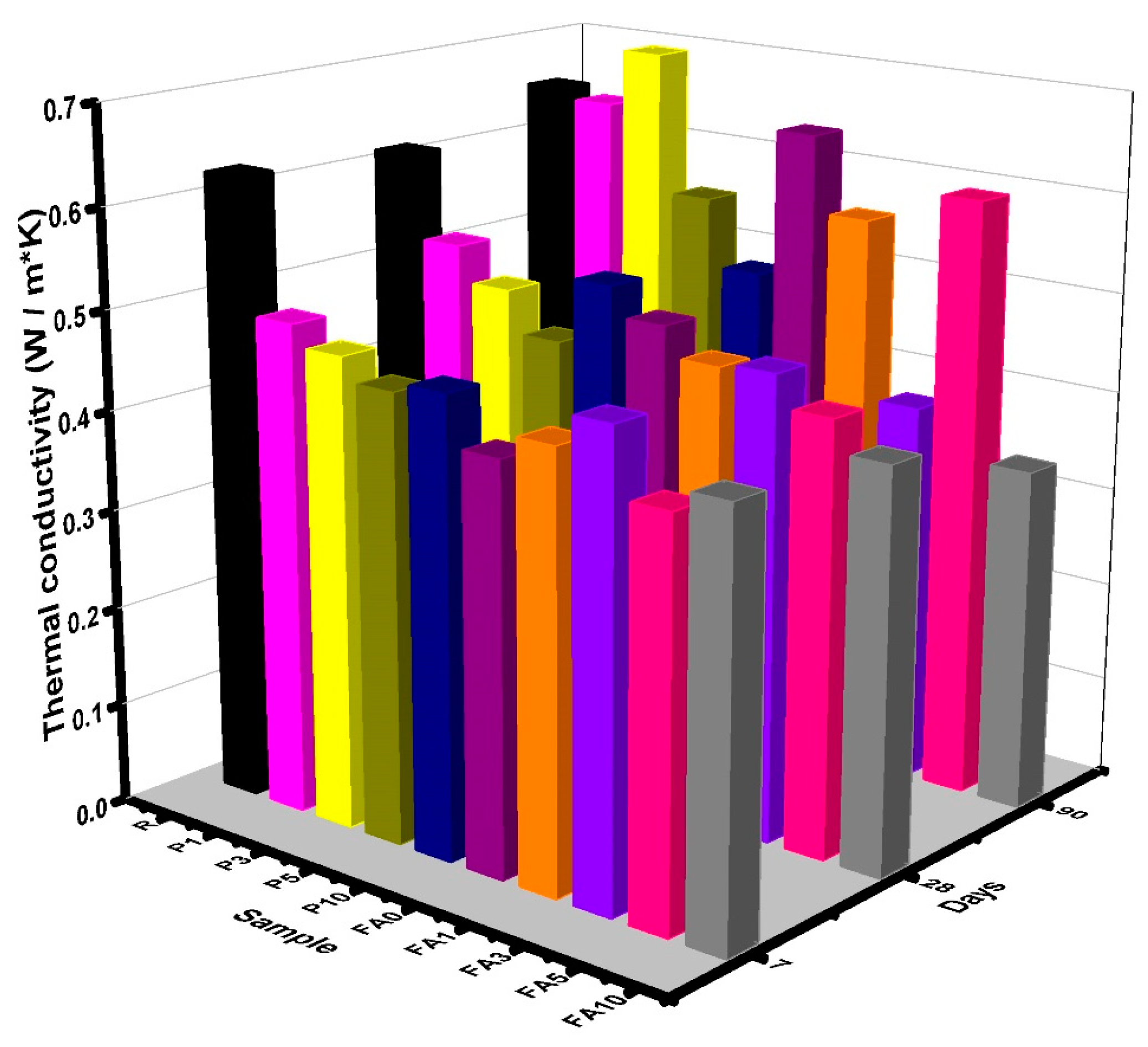

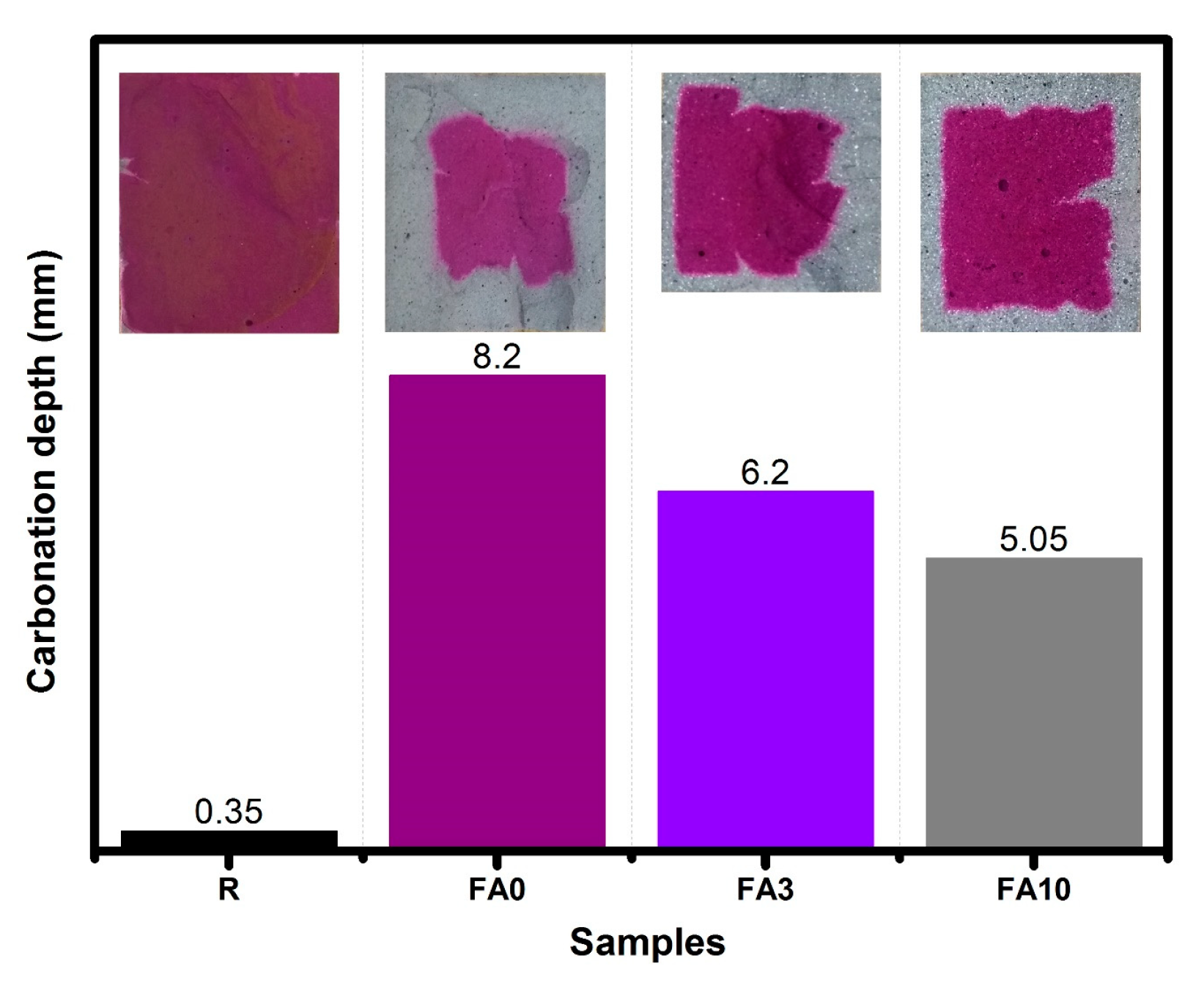
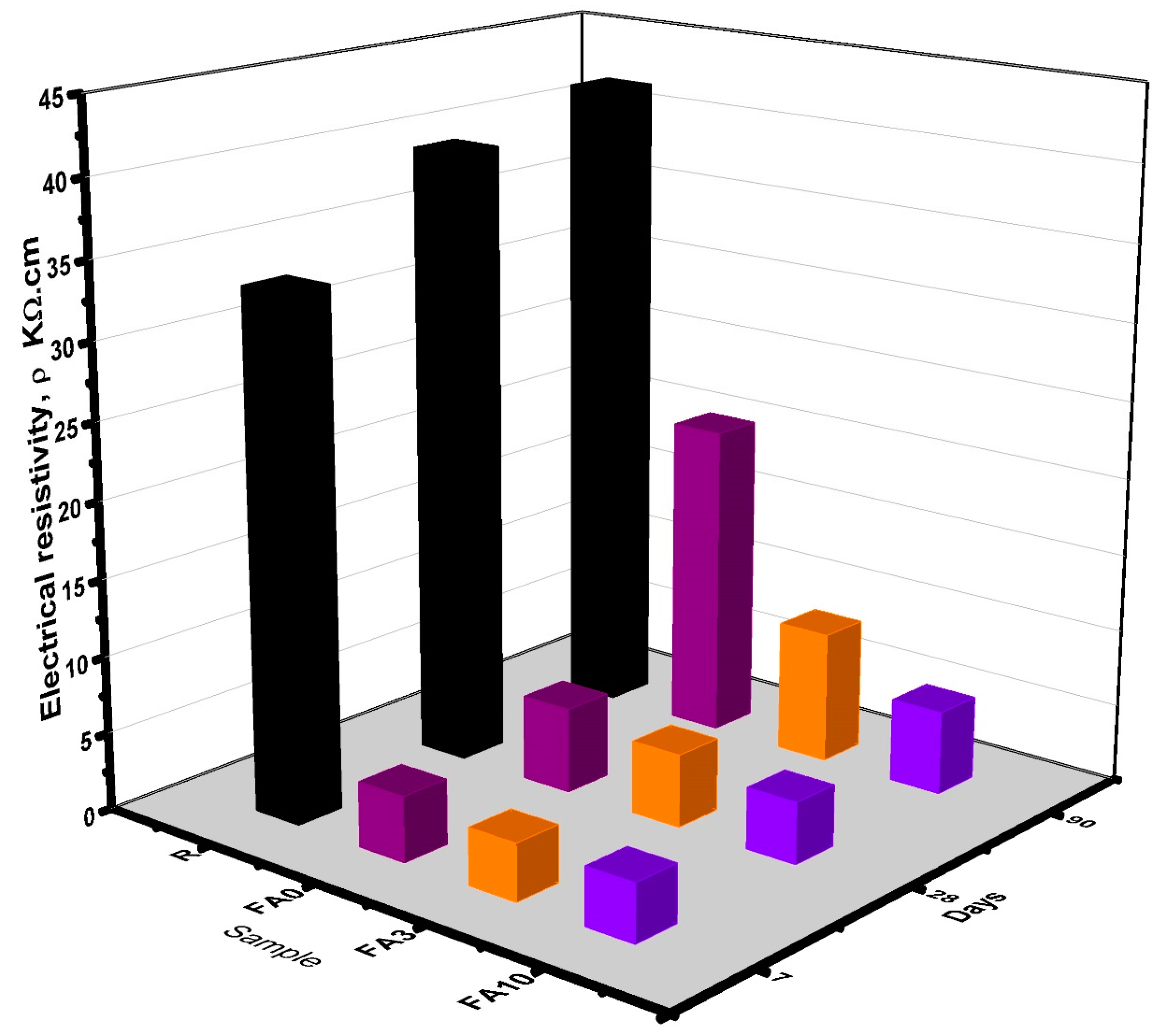


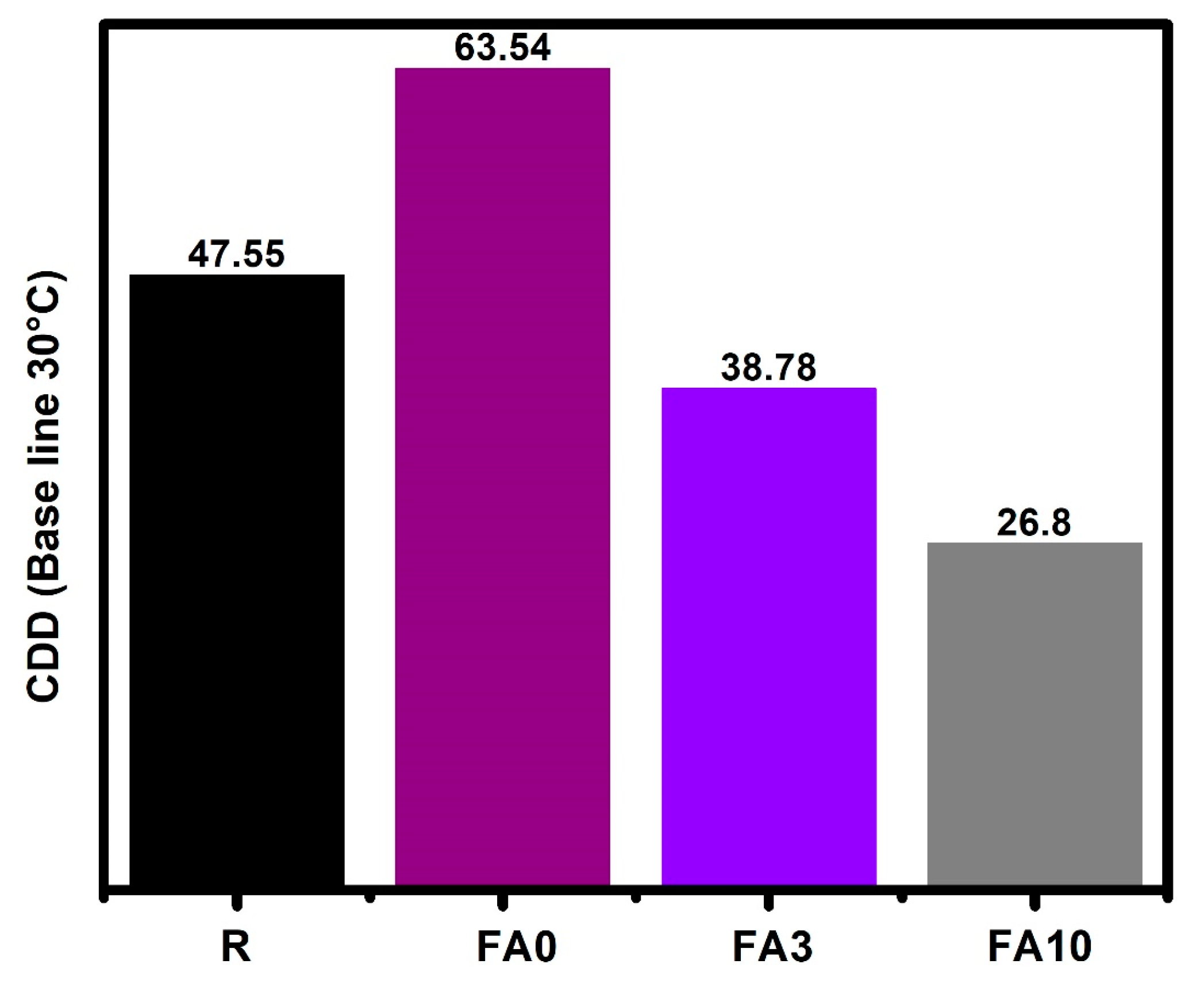
| Oxide (%) | ||||||||||||
|---|---|---|---|---|---|---|---|---|---|---|---|---|
| SiO2 | Al2O3 | Fe2O3 | CaO | MgO | SO3 | Na2O | K2O | TiO2 | P2O5 | MnO | LoI | |
| OPC | 19.82 | 4.97 | 1.99 | 61.47 | 1.48 | 4.53 | 0.5 | 0.81 | 0.24 | 0.1 | 0.04 | 0.04 |
| FA | 59.86 | 24.30 | 3.98 | 2.72 | 0.78 | 0.42 | 0.54 | 0.54 | 0.86 | 0.04 | 0.01 | 0.04 |
| Components | R | P1 | P3 | P5 | P10 | FA0 | FA1 | FA3 | FA5 | FA10 |
|---|---|---|---|---|---|---|---|---|---|---|
| Cement (gr) | 1500 | 1500 | 1500 | 1500 | 1500 | 750 | 750 | 750 | 750 | 750 |
| Fly ash (gr) | -- | -- | -- | -- | -- | 750 | 750 | 750 | 750 | 750 |
| PCM (gr) | -- | 15 | 45 | 75 | 150 | -- | 15 | 45 | 75 | 150 |
| Nanosilica (gr) | -- | 15 | 15 | 15 | 15 | -- | 15 | 15 | 15 | 15 |
| Sample | Lineal Regression up to 6 h | R2 | Si (mm/s1/2) |
|---|---|---|---|
| R-90 | y = 0.0023x + 0.0971 | 0.98 | 0.00234 |
| FA0-90 | y = 0.0026x + 0.0026 | 0.99 | 0.00255 |
| FA3-90 | y = 0.0027x + 0.0877 | 0.98 | 0.00267 |
| FA10-90 | y = 0.0023x + 0.1482 | 0.98 | 0.00225 |
| Sample | Lineal Regression from Day 1 to Day 8 | R2 | Sf (mm/s1/2) |
|---|---|---|---|
| R-90 | y = 0.0005x + 0.4488 | 0.99 | 0.00049 |
| FA0-90 | y = 0.0007x + 0.5685 | 0.98 | 0.00066 |
| FA3-90 | y = 0.0027x + 0.0877 | 0.98 | 0.00047 |
| FA10-90 | y = 0.0007x + 0.4537 | 0.98 | 0.00067 |
Disclaimer/Publisher’s Note: The statements, opinions and data contained in all publications are solely those of the individual author(s) and contributor(s) and not of MDPI and/or the editor(s). MDPI and/or the editor(s) disclaim responsibility for any injury to people or property resulting from any ideas, methods, instructions or products referred to in the content. |
© 2024 by the authors. Licensee MDPI, Basel, Switzerland. This article is an open access article distributed under the terms and conditions of the Creative Commons Attribution (CC BY) license (https://creativecommons.org/licenses/by/4.0/).
Share and Cite
Ziga-Carbarín, J.; Gómez-Zamorano, L.Y.; Cruz-López, A.; Pushpan, S.; Vázquez-Rodríguez, S.; Balonis, M. Mechanical Properties and Durability of Composite Cement Pastes Containing Phase-Change Materials and Nanosilica. Materials 2024, 17, 3271. https://doi.org/10.3390/ma17133271
Ziga-Carbarín J, Gómez-Zamorano LY, Cruz-López A, Pushpan S, Vázquez-Rodríguez S, Balonis M. Mechanical Properties and Durability of Composite Cement Pastes Containing Phase-Change Materials and Nanosilica. Materials. 2024; 17(13):3271. https://doi.org/10.3390/ma17133271
Chicago/Turabian StyleZiga-Carbarín, Javier, Lauren Y. Gómez-Zamorano, Arquímedes Cruz-López, Soorya Pushpan, Sofía Vázquez-Rodríguez, and Magdalena Balonis. 2024. "Mechanical Properties and Durability of Composite Cement Pastes Containing Phase-Change Materials and Nanosilica" Materials 17, no. 13: 3271. https://doi.org/10.3390/ma17133271
APA StyleZiga-Carbarín, J., Gómez-Zamorano, L. Y., Cruz-López, A., Pushpan, S., Vázquez-Rodríguez, S., & Balonis, M. (2024). Mechanical Properties and Durability of Composite Cement Pastes Containing Phase-Change Materials and Nanosilica. Materials, 17(13), 3271. https://doi.org/10.3390/ma17133271








